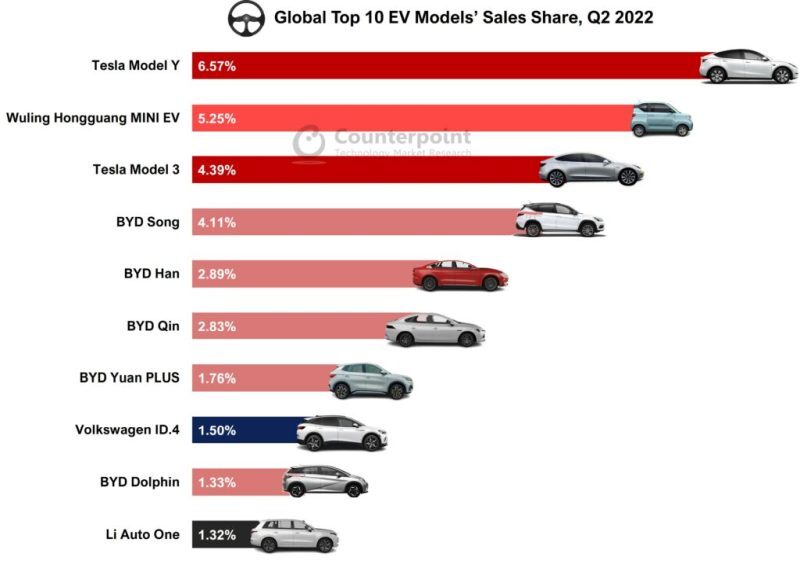Chinese Electric Vehicles: Disrupting The Global Auto Market

Table of Contents
Technological Advancements Driving Chinese EV Success
The success of Chinese electric vehicles is deeply rooted in significant technological advancements. These innovations are not just incremental improvements; they represent a paradigm shift in battery technology, electric motor efficiency, and autonomous driving capabilities.
Battery Technology Innovation
China is a global leader in battery technology, largely thanks to companies like Contemporary Amperex Technology Co. Limited (CATL), the world's largest battery maker. CATL's dominance is fueled by continuous innovation in lithium-ion battery chemistry, resulting in higher energy density, longer lifespans, and faster charging times. Further advancements include exploration into solid-state batteries, promising even greater energy density and safety improvements, which will be crucial for extending the range and performance of future Chinese electric vehicles.
- LFP (Lithium Iron Phosphate) batteries: Cost-effective and safe, making them ideal for mass-market EVs.
- NMC (Nickel Manganese Cobalt) batteries: Offer higher energy density compared to LFP, suitable for higher-performance vehicles.
- Solid-state batteries: The next generation of battery technology, promising increased safety, energy density, and charging speed.
Electric Motor Efficiency and Performance
Chinese manufacturers are also making significant strides in electric motor technology. Improvements in motor design and control systems have led to increased efficiency, resulting in longer driving ranges and improved performance. Companies are focusing on permanent magnet synchronous motors (PMSM) and asynchronous motors (induction motors), each with its own advantages in terms of cost, efficiency, and power output.
- Higher torque output: Leading to quicker acceleration and improved hill-climbing capabilities.
- Improved thermal management: Ensuring consistent performance even under demanding conditions.
- Reduced energy consumption: Maximizing the range on a single charge.
Autonomous Driving Capabilities
The development of autonomous driving technology is another area where Chinese electric vehicles are making rapid progress. Several Chinese companies are investing heavily in advanced driver-assistance systems (ADAS) and fully autonomous driving capabilities, leveraging advancements in artificial intelligence (AI), sensor technology, and high-precision mapping. While fully autonomous vehicles are still under development, the integration of advanced features like lane keeping assist, adaptive cruise control, and automated parking is becoming increasingly common in new models.
-
AI-powered algorithms: Enable sophisticated driver assistance and autonomous driving features.
-
LiDAR and radar sensors: Provide accurate environmental perception for safe autonomous navigation.
-
High-definition mapping: Enables precise vehicle localization and navigation.
-
Key Technological Advantages of Chinese EVs: Superior battery technology, highly efficient electric motors, increasing advancements in autonomous driving capabilities, competitive pricing.
Competitive Pricing and Market Strategies
The affordability of Chinese electric vehicles is a key driver of their global success. This competitiveness stems from a combination of cost-effective manufacturing, aggressive pricing strategies, and significant government support.
Cost-Effectiveness of Manufacturing
Chinese EV manufacturers benefit from lower manufacturing costs compared to their international counterparts. This is due to several factors, including access to a robust and cost-effective supply chain, economies of scale, and a highly skilled workforce.
- Efficient supply chains: Access to a vast network of suppliers and manufacturers within China.
- Economies of scale: High production volumes lead to lower per-unit manufacturing costs.
- Government subsidies: Financial incentives reduce production costs and make EVs more affordable.
Aggressive Pricing Strategies and Market Penetration
Chinese EV makers are employing aggressive pricing strategies, making their vehicles significantly more affordable than comparable models from established automakers. This competitive pricing enables rapid market penetration, particularly in developing countries where price is a major factor in purchasing decisions.
- Value-for-money proposition: Offering advanced features at a lower price point.
- Targeted marketing campaigns: Reaching specific demographics and market segments.
- Direct-to-consumer sales models: Cutting out intermediaries and reducing costs.
Government Support and Incentives
The Chinese government has played a crucial role in fostering the growth of the domestic EV industry through substantial government support and incentives. These policies include subsidies for EV purchases, tax breaks for manufacturers, and investments in charging infrastructure.
-
Subsidies for EV buyers: Making EVs more affordable for consumers.
-
Tax breaks and incentives for manufacturers: Reducing production costs and boosting investment.
-
Development of charging infrastructure: Addressing range anxiety and promoting wider adoption.
-
Competitive Advantages of Chinese EV Pricing: Lower manufacturing costs, aggressive pricing strategies, government support.
Expanding Global Presence and Market Share
Chinese electric vehicles are rapidly expanding their global reach, challenging established automakers in international markets. However, this expansion comes with its own set of challenges and opportunities.
Export Strategies and International Partnerships
Chinese EV companies are employing various strategies to penetrate international markets, including direct sales, establishing local manufacturing facilities, and forging strategic partnerships with local distributors. Companies like BYD and NIO are increasingly visible in Europe and other regions.
- Direct sales: Establishing direct sales channels to reach consumers directly.
- Joint ventures and partnerships: Collaborating with local companies to leverage existing distribution networks.
- Local manufacturing: Setting up manufacturing facilities in target markets to reduce transportation costs and tariffs.
Growing Brand Recognition and Consumer Perception
Overcoming perceptions regarding quality and reliability has been crucial for Chinese electric vehicles. Through sustained investment in research and development, improved quality control, and effective marketing campaigns, many Chinese EV brands are successfully building their global brand image and reputation.
- Improved build quality and reliability: Addressing concerns about durability and longevity.
- Strong after-sales service and customer support: Building trust and loyalty among consumers.
- Targeted marketing and branding campaigns: Promoting the features and benefits of Chinese EVs.
Challenges and Obstacles in Global Expansion
Despite their rapid progress, Chinese EV makers still face significant challenges in international markets. These include trade barriers, regulatory hurdles, geopolitical considerations, and competition from established players.
-
Trade tariffs and import duties: Increasing the cost of exporting vehicles to certain regions.
-
Regulatory compliance and certification requirements: Navigating varying safety and emission standards in different countries.
-
Geopolitical tensions and trade disputes: Creating uncertainty and potential barriers to market access.
-
Current Global Market Share of Chinese EVs: Growing rapidly, with significant market share gains in several key regions. (Specific figures should be inserted here based on up-to-date data).
-
Future Projections: Expected continued growth, with Chinese EVs becoming increasingly competitive on a global scale.
The Future of Chinese Electric Vehicles and Global Competition
The future of the global automotive industry will be significantly shaped by the continued growth and innovation of Chinese electric vehicles.
Innovation and Future Technological Trends
Chinese EV manufacturers are continuing to invest heavily in research and development, pushing the boundaries of battery technology, autonomous driving, and other key areas. We can expect further advancements in solid-state batteries, more sophisticated autonomous driving features, and the integration of advanced connectivity technologies.
- Next-generation battery technologies: Solid-state batteries, improved lithium-ion chemistries.
- Advanced driver-assistance systems (ADAS): Enhanced safety features and autonomous driving capabilities.
- Vehicle-to-everything (V2X) communication: Improving traffic flow and safety.
The Impact on Established Automakers
The rise of Chinese electric vehicles poses a significant competitive threat to established automakers worldwide. The combination of advanced technology, competitive pricing, and aggressive market strategies is forcing traditional automakers to accelerate their own EV development and adapt to the changing market dynamics.
Sustainability and Environmental Concerns
While the increased adoption of EVs is generally positive for the environment, it's important to consider the environmental impact of the increased production and mining of raw materials needed for batteries and other components. Sustainable sourcing and recycling initiatives will be crucial to mitigating the environmental footprint of the growing EV industry.
- Long-Term Implications: Increased competition, technological advancements, and a shift towards sustainable transportation.
Conclusion: The Unstoppable Rise of Chinese Electric Vehicles
The evidence is clear: Chinese electric vehicles are rapidly transforming the global automotive landscape. Their technological prowess, competitive pricing, and expanding global presence are disrupting the established order. While challenges remain, the future of the industry looks bright for Chinese manufacturers. The innovations in Chinese electric vehicles, from battery technology to autonomous driving, represent a powerful force poised to reshape the way the world drives. To stay informed about the ongoing advancements in this dynamic sector, explore resources such as industry publications, company websites, and research reports dedicated to the evolution of Chinese electric vehicles. The future of transportation is electric, and China is at the forefront of this revolution.

Featured Posts
-
 American Jorgenson Retains Paris Nice Championship
Apr 26, 2025
American Jorgenson Retains Paris Nice Championship
Apr 26, 2025 -
 Federal Agency Questions Jewish Affiliation Of Columbia And Barnard Staff
Apr 26, 2025
Federal Agency Questions Jewish Affiliation Of Columbia And Barnard Staff
Apr 26, 2025 -
 Mission Impossible Dead Reckoning Part Two Big Game Spot Breakdown
Apr 26, 2025
Mission Impossible Dead Reckoning Part Two Big Game Spot Breakdown
Apr 26, 2025 -
 Potential Deion And Shedeur Sanders Issues A Browns Insider Weighs In
Apr 26, 2025
Potential Deion And Shedeur Sanders Issues A Browns Insider Weighs In
Apr 26, 2025 -
 Bmw And Porsches China Challenges A Growing Trend Among Automakers
Apr 26, 2025
Bmw And Porsches China Challenges A Growing Trend Among Automakers
Apr 26, 2025
